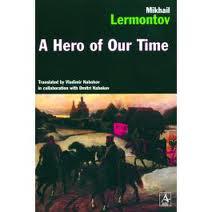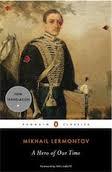A Hero of Our Time tells the story of Pechorin first through the stories of his commanding officer and later through his personal journals. The narrator has almost nothing to do with the story and has met Pechorin only once for a very short time, so we can assume that he is (at least for the most part) unbiased. The novel is divided into short books, each of which deals with a different story about Pechorin. The majority of these stories deal with fate and whether or not a man can control or change what he is predestined for, and how Pechorin feels about marriage and women.
As with most classics this book would make for an excellent discussion piece. There are a lot of things being discussed in this novel, the biggest topic being that of the “superfluous man” or, as stated in the

author’s note of the copy I read, a “hero” who indulges in all the vices present in the young people of the time. The time being 1830s and 40s. The vices Pechorin indulges in are still problems for people today and in that respect the book still holds true today. We still indulge in hyperbole when describing our personal adventures (over Facebook more than anything else probably), there is still selfishness and desire to have what we don’t possess but someone else does, and the desire to control our lives and leave nothing up to fate or chance while still wondering what power fate has over our lives. (These are by no means the only points brought up in the book, but the ones I’ve chosen to pick out). Lermontov also talks about Byronic poetry quite a lot and there are many allusions to Byron throughout the text. Not being a great fan of Byron personally this did nothing to win me over.

The one thing that really got under my skin in this novel was Pechorin’s treatment of women. I realize that women were usually always portrayed badly in books written at this time but something about Pechorin made it even worse. We start the novel hearing about how Pechorin kidnaps and forces into a marriage a woman he likes only because someone else is falling in love with her, and he gets the girl’s brother to give her up by trading her for a horse. Later in the book (but earlier in Pechorin’s timeline) we hear about how Pechorin makes women a type of sport, trying to seduce them away from other men just so he can see these other men miserable with no regard to how it affects the girls and their reputations. This adds a very interesting layer to the text, but also left me frustrated.
Lermontov did not create Pechorin to be loved, and on that account he succeeds. Pechorin is still un-likable in the 21st century. Lermontov has crafted a timeless book and one that should probably be read by all lovers of Russian lit (or Byron). That being said the book is also very slow and there were times I had to force myself through it by reminding myself I have to teach it. This won’t be going on my list of favorite books, but it is a good (and at 170 pages short) introduction to Russian lit and might be worth reading before you jump into something like Anna Karenina.


